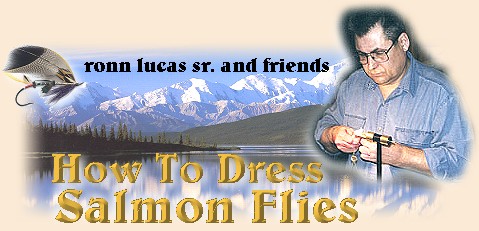
1. Pull a bit of orange Gocha from the Gocha
"rope" and tie it to the rear of the hook. Hold
the Gocha on top of the hook and take one "soft
loop" (no thread tension) around the hook and
Gocha which will roll the Gocha around the hook.
Pull tight on the second turn. This in effect
makes a collar of Gocha.
Note: Use this soft loop technique on just
about any material you want to encircle the hook.

2. Attach the Blue Marlin Crystal Cloth to the base
of the Gocha and secure the Gocha and tinsel tightly
and advance the thread to the location of the next
color of Gocha.

This photo shows what Crystal Cloth looks like and how to
use it. When unraveled, the Mylar has a distinct "scaly"
appearance that to me looks "fishy." The small fibers
(red in this pic) are useful for spinner wings and small flies.

3. Attach a bit of red Gocha and 24K Crystal Cloth as before.

4. Attach a bit of purple Gocha as before. Attach the
black Gocha and finish the fly as shown.

5. The finished fly.
Tying the Gocha Girl using the loop method, use
the same materials as the bunch method.

1. Lay out the Gocha on the bench using about 3/4" to 1"
for each color. The length to trim the fibers is up to the
Tyer. This fly has fibers about 2" long with the black
about 3" long. If you gently press the material flat, it
should cling to itself enough to be able to pick it up
and insert in into the loop. You want only enough material
at the head so there isn't a big bunch to tie off. It will
take a couple flies to determine just how much is just right.

2. Attach the thread to the rear of the hook at
about the bend. Make a dubbing loop and insert the
prepared Gocha into the loop. Lay out the Gocha on
the bench using about ¾" to 1" for each color. The
length to trim the fibers is up to the Tyer. This
fly has fibers about 2" long. Position the material
as shown with 90% of the fibers to one side of the
loop.

3. Twist the loop JUST TIGHT ENOUGH TO HOLD THE GOCHA
IN THE LOOP! If the loop is too tight, you will not
be able to pick out the Gocha. The dubbing loop is
not what will be holding the Gocha in the finished fly.
Note: This picture doesn't show it but, I use
a loop tool that I made which is basically just a
Shepard's Hook that is inserted in the bottom of the
thread loop to hold the loop tight. A pair of hackle
pliers can also be used.

4. Wrap the Gocha around the hook with TIGHT turns.
It is these tight turns that secure the Gocha to the
hook. On each turn, pull the previous turn of Gocha
back so the next one doesn't trap any (or, as few
as possible) of the Gocha under it.

5. Using a very stout bodkin, aggressively pick out
the Gocha in all directions around the hook as shown.
I use bodkins I made for myself that use very heavy
wire needles. Some are carpet needles and others are
sail makers needles. A very strong needle is needed
for this procedure, most if not all of the ones on
the market will be bent if tried on this.


6. Pull the Gocha back as shown and finish fly.
Note: Both of these methods result in flies
that look and behave the same in the water. My
personal favorite method is the dubbing loop. Both
will take about the same amount of time to tie.

Gocha Green Alaskabou, tied by Ronn Lucas, Sr.



